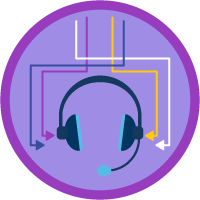Service Cloud Specialist
Configure Service Cloud to optimize case management, knowledge sharing, and analytics.
Service Cloud Specialist
Ce que vous devez accomplir pour gagner ce superbadge
- Design and update an agent console
- Implement case management features
- Display service level actions
- Configure case routing from email to agent
- Create a knowledge-sharing platform
- Establish case and agent automation systems
- Build case analytics
Concepts testés avec ce Superbadge
- Lightning Console
- Case management tools
- Entitlement management
- Case email
- Case routing
- Lightning Knowledge
- Automation tools
- Reports & Dashboards
Prework and Notes
- Grab a pen and paper. You may want to jot down notes as you read the requirements.
- Create a new Trailhead Playground for this superbadge. Using this org for any other reason might create problems when validating challenges.
- Your users will be on the Salesforce Lightning Experience, so make all design decisions with this in mind.
- Some of the terminology used in this superbadge is descriptive and may not match the name as it appears in the UI. This is to test your knowledge of Salesforce features and ability to select the correct feature to satisfy a business need.
Use Case
Ursa Major Solar, Inc., is a US-based solar energy equipment supplier that recently expanded its operations to the Pacific Northwest. New customers have been happy with the power generated during long, sunny summer days, often producing a surplus that is sent back to the power grid. With a change in weather to clouds and rain during shorter winter days, though, energy production is down and customers are feeling concerned about using more than they produce.
At Ursa Major, a customer's pain is your pain, and the leadership team has decided to open a new contact center focused on listening to customers in the Pacific Northwest and maximizing their possible power production. You are the admin tasked with implementing Service Cloud features to ensure the success of the new Cloudy Support Team's mission. You will set up case management logic, design interaction channels and case routing, establish knowledge sharing, create an agent console that maximizes efficiency, and even provide analytics for managers to track case trends. Most importantly, you will provide a way for Ursa Major's customers to get the great support they deserve!
Key Stakeholders
Before you listen to customers, you've listened to your broader team to understand how the contact center should function. Your key stakeholders are:
- Ada Balewa (product support specialist)
- Maria Jimenez (system administrator)
Standard Objects
Ursa Major uses these standard objects.
- Account—Customer who purchases from Ursa Major Solar
- Contact—Prospective and existing customer contacts of Ursa Major Solar
- Case—Support issue reported by a customer
Business Requirements
Agent Support Interface
Part of Ursa Major's strategy to delight customers is to first keep employees happy. If the Cloudy Support Team is more chipper thanks to free fruit and improved Lightning, they are more likely to provide a more positive customer experience. So you will build a friendly Lightning agent support interface, configure it for efficiency, and continue to tweak it as this project continues and new features can be incorporated.
Create two new profiles to assign to users:
- Cloud Team Billing Support: Salesforce Licensed Users who access Accounts, Contacts, Cases, and Contracts.
- Cloud Team Technical Support: Salesforce Licensed Users who access Accounts, Contacts, and Cases, but not Contracts.
Improve on the Service Console app that already exists. Here are some notes from Maria Jimenez, system administrator, and Ada Balewa, product support specialist, to get started.
- Rename the console
Cloudy Support Service Console. - Assign the color scheme #106935.
- Update the utility bar with a soft phone, a way to automate the completion of otherwise manual tasks, and a quick way for the agent to review a history of the five most recent cases.
- Ensure anyone with the Cloud Team Billing Support Profile or Cloud Team Technical Support profiles can access the console.
To keep up productivity, also add the option for agents to compose emails within the console while looking at a case. To help with testing and user acceptance, add a login for Ada and provide her with the Cloud Team Technical Support profile.
Case Management
If you imagine a contact center is a body, the eyes and ears are interaction channels, agents are the muscles, and cases are its bloodstream. Cases carry the vital information that your agents need to help your customers. Case management helps you direct, organize, and escalate cases based on business requirements. Maria Jimenez, Ursa Major's Salesforce administrator, helped you gather and organize the requirements for the Cloudy Support Team.
Support Lifecycle
You would dress for a summer day in Seattle very differently than a winter day. You may wear sandals instead of snow boots, or a T-shirt instead of a rain poncho. Similarly, support agents handle billing cases differently than installation help cases. The Cloudy Support Team will make the biggest impact by starting with technical support issues, so let's go ahead and build the case page layout, support lifecycle on the Case object, and a way for agents to differentiate that they are working a technical support case.
| Case Lifecycle Name | Cloud Technical Team |
|---|---|
| Case Lifecycle Stages (you may need to add some of these) |
New Investigating Cause Investigating Solution Resolving with Customer Escalated Closed |
| Case information page name | Cloud Technical Team Page |
| Case information to display |
Same as existing Case Layout, but without: - Potential Liability - Product And adding: - Type - Case Reason - Escalated - Asset |
| Profiles with the case information pages |
- Cloud Team Technical Support - System Administrator |
Case Organization
Cases are stored and organized before being selected by (or assigned to) a support agent. If cases are the bloodstream, this organizational structure is like arteries, holding and prioritizing the blood before the muscles pick it up. Before building the case organizers, create three public groups that will be populated with agents as they join the team. The names for the public groups are:
- Basic Support Agents
- Intermediate Support Agents
- Advanced Support Agents
Add yourself and Ada to the Advanced Support Agents group.
There should be two case organizers: Basic Case Organizer and Advanced Case Organizer. Basic and intermediate support agents should be able to grab cases from the Basic Case Organizer, while intermediate and advanced agents should be able to select cases from the Advanced Case Organizer.
While an agent can manually move a case into one of the case organizers as needed, create custom rules that automatically place new cases in the appropriate organizer. New cases should always go to the Basic Case Organizer unless the priority of the case is High. High-Priority cases should go to the Advanced Case Organizer.
The system should also push cases that need extra attention from the Basic Case Organizer up to the Advanced Case Organizer so the more experienced agents can help out. If a case's priority is Low, and the status isn't Escalated, Closed, or Resolving with Customer, the case should get pushed up after 3 hours of inactivity. If a case's priority is Medium, and the status isn't Escalated, Closed, or Resolving with Customer, the case should get pushed up after 3 hours of being created.
Support Is a Team Sport
Ada has been successful thanks to the group of people she regularly works with to solve cases. You want to set up the Cloudy Support Team with the ability to assign staff that they regularly collaborate with on the case. There are two roles that should be included: Customer Contact, with the ability to read the case, and Support Lead who can read and edit the case. Add a way for agents to customize who is assigned to each role for each case.
Support-Level Management
Sita Nagappan-Alvarez, the CEO of Ursa Major Solar, regularly stresses the value of every single customer. From large multibuilding office park installations to single-family homes, every solar system sold helps the company's bottom line and the environment. While the support team has industry-leading time-to-close and customer satisfaction numbers, some customers want a more stringent Service Level Agreement, and are willing to pay extra for this service. In response to this request, the Support Leadership Team has outlined two plans: paid Cirrus Support and automatically included Stratus Support. You will implement the Cirrus Support plan and make it available to agents.
| Support level name | Cirrus Support Process |
|---|---|
| First required step | Resolution Time Should be completed within 360 minutes for high-priority cases. The case owner should be sent a warning email when 45 minutes are left. |
| Second required step | Resolution Time Should be completed within 840 minutes for low- or medium-priority cases. |
| Third required step | Initial Response Should be completed within 20 minutes for low-, medium-, and high-priority cases. If this isn't completed, 10 minutes later a High priority task should be created for the case owner to contact the customer. |
If a customer pays for extra support, but no agents can tell, did they really pay for support? Yes! To help agents keep track of support plans, update the account view to allow adding Cirrus Support Plans to accounts and a tab on the service app to see support-level assignments overall. Update the case view so agents can track progress on the required steps.
Note: In this superbadge, you will not need to apply case plan steps to cases created from emails. There is a trigger which does this automatically for you. Talk to your developer if you want this functionality in your org!
Case Routing
With case management and support levels established, let's build the first and last leg of support that will make your customer's experience with support as seamless as possible.
Processing Emailed Cases
Between new social media platforms, mobile, messenger apps, and even calling on the phone(!), there are nearly as many ways for customers to contact support agents as there are clouds in the Seattle winter sky. The Cloudy Support Team would like to start with email. According to analysis of existing Ursa Major support case sources, email continues to be a primary channel for customers to submit and follow through with support issues. Set up a way for incoming emails to be processed into cases with the following settings, without the need to install any desktop apps.
| Channel name | Cloudy Email Routing |
|---|---|
| Email address | Your email address (different than the email address for your user profile) |
| Generated case owner | Basic Case Organizer |
| Generated case priority | Medium |
| Generated case origin |
Ada reported that she regularly receives two emails from customers per issue: one with their question or problem, and the second with a message saying, "Did this go through?" Maria has recommended that you set up an automated system that will reply to customers on all new cases generated by email. Call the system Cloudy Email Response Rule. These replies should appear to come from "Ursa Major Cloudy Support Team" with the email address assigned to your username. Create an email template called "Support: Cloudy New Email From Case" that should be used.
Routing Case Traffic
Returning to our "contact center as a body" metaphor, we now need to build the capillaries, the final step to direct the blood (cases) to the muscles (agents). Should all agents be presented with all available cases? How many cases should an agent be able to take on simultaneously? If an agent decides to go outside to look at clouds, how do they log their break in the system? The Ursa Major leadership team made decisions on these questions, and you get to implement the case routing system. The channel, Stormy Cases, will route cases based on two situations.
- The top-priority situation, Advanced Cases, will pull from the Advanced Case Organizer, assign two units of work to each case, and present them to agents that have been available the longest.
- The lower-priority situation, Basic Cases, will pull from the Basic Case Organizer, assign one unit of work to each case, and also present the cases to agents who have been available the longest.
Agents prepared to take Stormy Cases should have the option to select Available. When busy or not available, they should have these options:
- Unavailable - Break
- Unavailable - Off
- Unavailable - Working Cases
If an agent picks up a case, but decides it's wrong for them, they should be able to send it back by selecting Wrong Queue.
As a reminder, the agents will have the Cloud Team Technical Support profile.
Case Expertise Sharing
When Ada isn't handling customer cases, she's sharing her solar panel expertise with other support agents. Acting as a mentor is helpful to the person she is talking to, but when ramping up a new contact center with dozens of new agents, a more scalable approach is required. Build out Lightning Knowledge so Ada and other agents can catalogue their expertise.
Build Lightning Knowledge
You and Ada will need access to knowledge. There are two major groups and several subgroups that will help organize knowledge articles.
- Billing Topics
- Reimbursements
- Payments
- Technical Topics
- Panel Access
- Connections
- Broken Equipment
Confirm Rich Text Area fields: Question and Answer are available for the article writer to fill in when creating an article. Create and publish an article.
| Title | Linking SP-100 to SP-200 |
|---|---|
| Question | How does the SP-100 connect to the SP-200? |
| Answer | You should use the UM-B linker to connect the SP-100 and SP-200 panels. |
| Category | Connections (under Technical Topics) |
| Status | Published |
Update the agent's case view to include published articles and to assign an article to a case.
Automated Agent Activities
While drinking a coffee with Ada, she told you about her first month at Ursa Major. There was a regional power outage that knocked a large portion of customers off the grid and produced five times the number of support calls they normally saw, all asking how to restart their systems. Agents worked overtime for days to handle the case backlog and to this day talk about the Great Outage of 2013. Ada anticipates a similar case influx when extreme overcast or stormy weather decreases energy production. Maria recommends you build some automation to avoid overwhelming the Cloudy Support agents when these cases pour in.
Automated Tasks
Before empowering agents to handle weather-related panel underperformance cases with just a button click, we want to ensure that the weather is, indeed, to blame. Create automation that assigns a new task to the agent working the case if it is of case type Electrical, the reason is Performance, and the status is Working. The task should have these characteristics assigned.
| Subject | Research the weather |
|---|---|
| Description | Recent poor performance has been attributed to cloudy weather. Research the customer's weather at the time of poor performance. |
| Status | Not started |
| Priority | Normal |
| Related to | The original case |
Reusable Email
Create a reusable email so agents don't have to craft an email about the weather-related panel underperformance for every customer. Replace the [bracketed] text with a function that automatically fills in with information from the case.
| Reusable email name | Cloudy weather |
|---|---|
| Subject | Low power generation in cloudy weather |
| Body | Hey [customer's first name], Sorry to hear that your panels aren't generating the power you hoped for. Based on our research, it appears the low power produced is related to the cloudy weather in your area recently. In the worst conditions, Ursa Major panels produce ~25% of maximum power. If you have additional questions, please give us a call and reference case [case number]. Thanks! [Agent first name], Ursa Major Solar |
Reusable Text
Having an email that can be applied repeatedly is great, but what about text that can be applied in even more places? The Cloudy Support agents will use this text to update the case after using the reusable email. Again, replace the [bracketed] text with a function that automatically fills in information.
| Reusable text name | Cloudy weather response sent |
|---|---|
| Text | Agent [agent's name] sent the Cloudy Weather email to the customer and closed the case. |
| Category | FAQ |
| Channel | Internal |
Automated Actions
What saves even more time than an agent applying a reusable email and reusable text? An agent clicking a button in the console that automatically applies the reusable email, text, and other actions while the agent relaxes. Here are the high-level actions that should be completed. Name the automated action: Cloudy Weather Resolution
- Select the case currently being worked.
- Send an email to the customer using the Cloudy Weather reusable email for the subject and body.
- Close out the case, adding the Cloudy weather response sent reusable text to the description.
Contact Center Analytics
With the case routing, management, and automation you have built, the Cloudy Support Team should be off to a great start. To help the team evaluate its case effectiveness, you'll build out a report and update a dashboard.
First, create a report to help support management understand why customers are reaching out. Build the Case Reason and Type Analysis report and store it in the Cloud Support Reports folder. Organize first by type, then by case reason, with the most frequently used type shown first and the least frequently used shown last. Display the case owner, account name, and subject, and only closed cases. Include a graph on the report where each column represents a type and case reasons align atop each other.
Second, create the Case Performance Dashboard with your new report. Display your analysis with each type as its own column, grouped together by Case Reason. Name it Case Reason and Types with the subtitle Case Distribution Analysis. Place your component in the middle of the dashboard and expand it to maximize its size to utilize the space.





